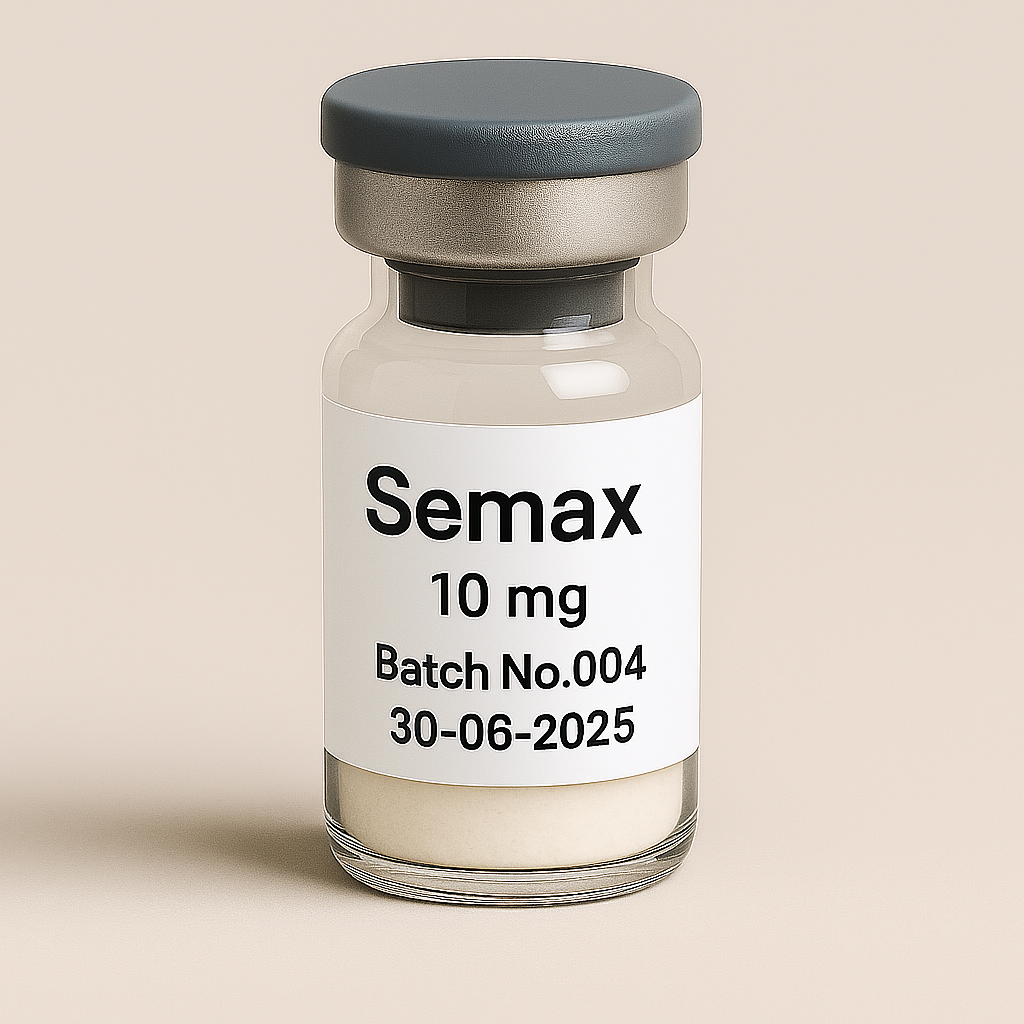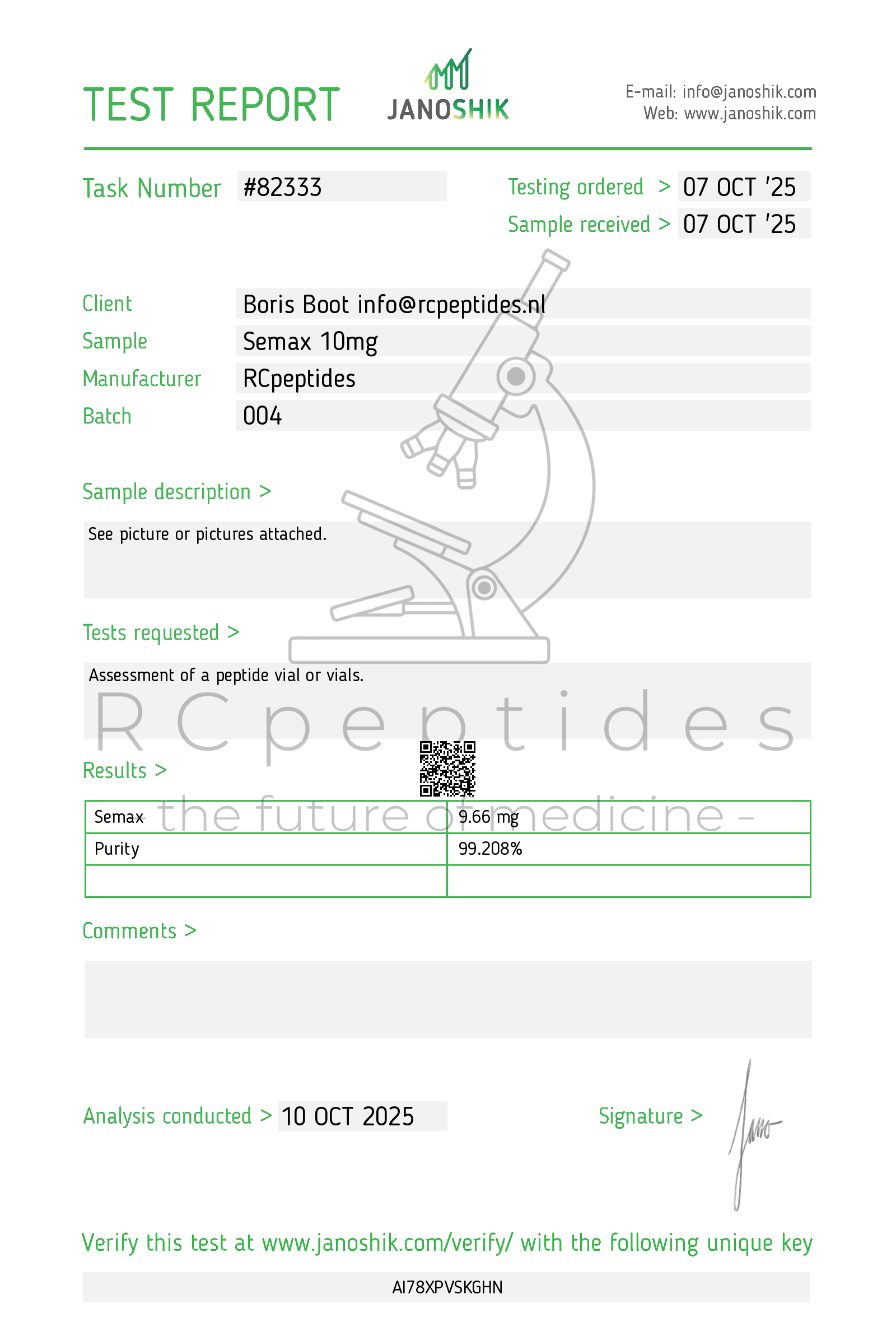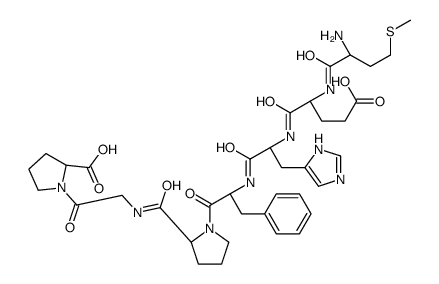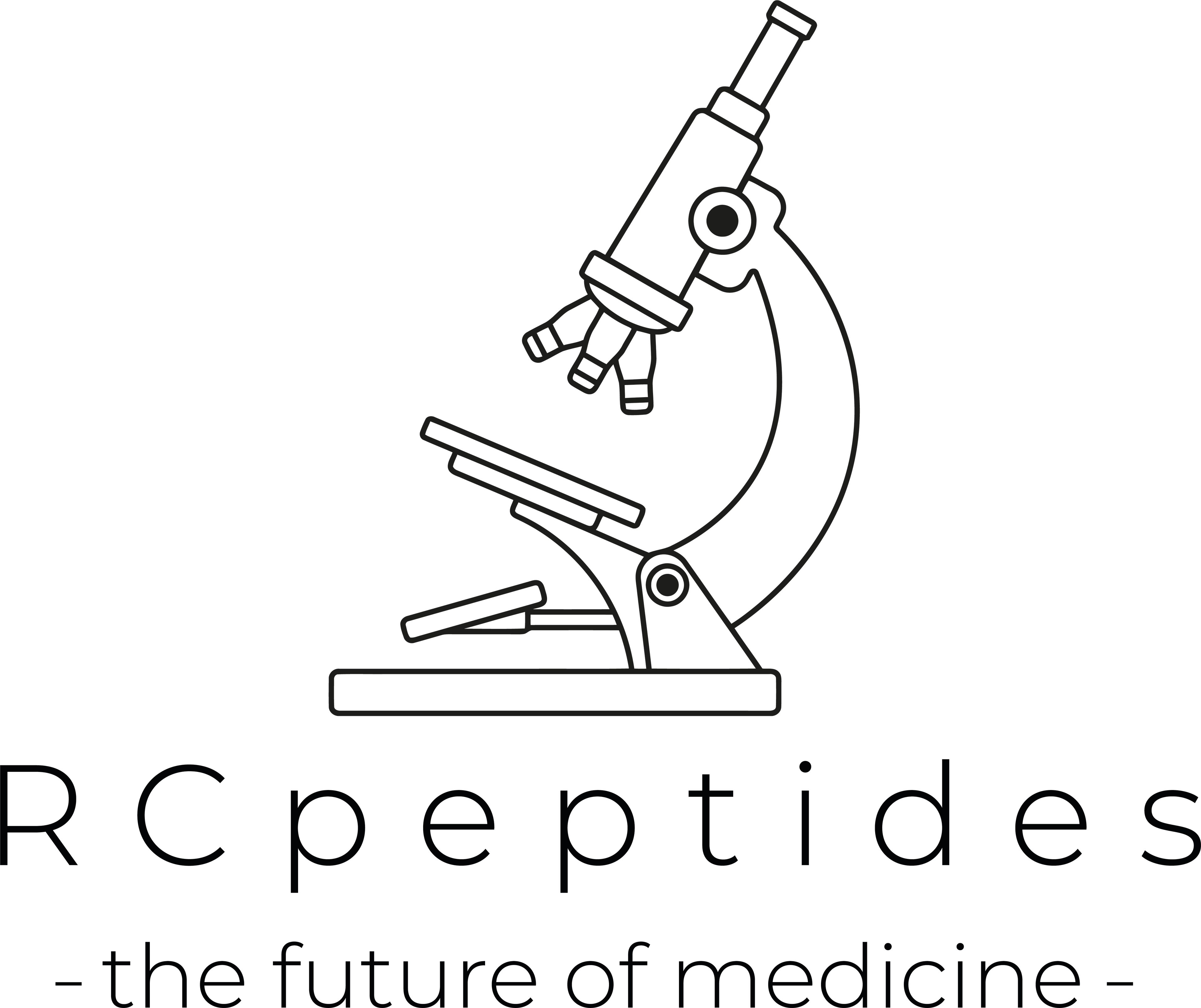
Semax 10mg vial
Pickup currently not available
NOT FOR HUMAN CONSUMPTION
Semax is a synthetic peptide developed in Russia in the 1980s by the Institute of Molecular Genetics at the Russian Academy of Sciences. Originally intended for stroke treatment, Semax is recognized for its nootropic, neuroprotective, neurogenic, and cognitive-enhancing properties. It is utilized clinically in Russia and parts of Eastern Europe, notably prescribed for cognitive disorders, brain injuries, and neurological deficits.
Chemical and Pharmacological Background
-
Chemical Composition: Synthetic analogue of adrenocorticotropic hormone (ACTH); specifically, the peptide ACTH(4-10): Met-Glu-His-Phe-Pro-Gly-Pro.
-
Molecular Weight: Approximately 813.9 g/mol.
-
Classification: Synthetic peptide; neuropeptide, nootropic, neuroprotective agent.
-
Formulations: Commonly administered intranasally or via subcutaneous injection.
Mechanisms of Action
Semax operates via multiple neurochemical pathways, explaining its diverse effects:
1. Neurotrophic Factor Modulation
-
Significantly increases levels of Brain-Derived Neurotrophic Factor (BDNF) and other neurotrophic factors.
-
Promotes neurogenesis, neuronal differentiation, survival, and improved neural plasticity.
2. Neuromodulation of Dopamine and Serotonin Systems
-
Enhances dopamine and serotonin signaling pathways, potentially improving mood, motivation, cognition, and emotional regulation.
3. Melanocortin System Activation
-
As a melanocortin receptor agonist (specifically MC4 receptors), Semax modulates stress responses, attention, memory, anxiety levels, and immune responses.
4. Anti-Inflammatory and Neuroprotective Properties
-
Reduces oxidative stress, inflammation, and neuronal damage following injury.
-
Promotes recovery after traumatic brain injury, stroke, ischemia, or neurodegeneration.
5. Enhanced Cerebral Circulation
-
Improves blood flow in cerebral tissues, delivering oxygen and nutrients more effectively, thus potentially improving cognitive function and brain health.
Potential Therapeutic and Clinical Applications
Semax is clinically approved and prescribed in Russia for numerous neurological conditions and cognitive disorders:
1. Cognitive Enhancement (Nootropic Uses)
-
Improves attention, memory, mental clarity, and learning capacity.
-
Potential applications for cognitive decline, ADHD, memory impairment, or cognitive fatigue.
2. Stroke and Cerebral Ischemia
-
Promotes recovery of neurological functions after stroke, transient ischemic attacks, or brain ischemia.
-
Clinically employed to reduce neurological deficits post-stroke.
3. Neuroprotection and Neurodegenerative Diseases
-
Potential therapeutic use in Parkinson’s, Alzheimer’s, dementia, or age-related cognitive decline due to neuroprotective and neurotrophic effects.
4. Anxiety, Stress Management, and Mood Disorders
-
Reduces anxiety and stress symptoms via modulation of stress-related neurochemical pathways.
-
Potential use in anxiety disorders, mild depression, PTSD, or stress-induced cognitive dysfunction.
5. Traumatic Brain Injury (TBI)
-
Supports neuronal regeneration, reduces inflammation, and improves outcomes following traumatic brain injury.
Dosage and Administration Guidelines
Semax is primarily administered intranasally or subcutaneously due to limited bioavailability orally.
Typical Dosage Ranges (Clinical and Experimental Use):
-
Intranasal Administration:
-
Standard Dose: 50–150 mcg per spray, usually 1–3 sprays per nostril, 1–3 times daily.
-
Daily Total: Usually ranges from 300 mcg to 900 mcg/day; higher doses occasionally used temporarily under medical supervision.
-
-
Subcutaneous Injection (less common outside clinical environments):
-
Typical Dosage: 200–1000 mcg/day, usually split into 1–3 injections.
-
Cycle Duration:
-
Typically used in cycles lasting several weeks, followed by breaks to monitor effects and avoid potential tolerance.
Safety Profile and Potential Side Effects
Semax demonstrates a notably favorable safety profile, with minimal side effects commonly reported:
Common Side Effects (Rare and Generally Mild):
-
Mild nasal irritation or discomfort from intranasal use.
-
Mild headache or transient dizziness (rarely reported).
Serious Adverse Effects:
-
Rare or unreported at therapeutic dosages.
Tolerance and Dependence:
-
Currently no strong evidence suggesting tolerance, addiction, or withdrawal risk at therapeutic doses.
Long-Term Safety Data:
-
Limited, but clinical experience in Russia suggests generally safe long-term usage with medical supervision.
Contraindications and Interactions
Contraindications:
-
Hypersensitivity or allergic reactions to peptide-based drugs.
-
Severe psychiatric conditions without medical supervision.
Interactions:
-
Few well-documented drug interactions.
-
Due to neurochemical modulation, caution is advised if combining Semax with psychotropic medications (SSRIs, MAOIs, stimulants) due to theoretical (though rarely reported) risks.
Legal and Regulatory Status
-
Russia & Eastern Europe: Semax is officially approved and prescribed by medical practitioners, available as prescription medication.
-
United States, Canada, EU, Australia: Not approved or regulated as a pharmaceutical. It is usually marketed through specialty supplement retailers or research chemical suppliers, typically labeled “for research purposes only.”
-
WADA (Sports Regulatory Agencies): Semax is currently not listed as a prohibited substance by WADA, but always consult updated prohibited substance lists.
Clinical and Scientific Research Status
Semax has been studied primarily in Russian research, though growing interest internationally has increased visibility:
Clinical Studies and Scientific Findings:
-
Significant increases in BDNF, neuronal growth, cognitive function, and reductions in oxidative stress demonstrated in animal and clinical studies.
-
Proven efficacy in stroke recovery and cognitive disorders in Russian clinical studies.
Limitations and Needs for Further Research:
-
Limited availability of large-scale, randomized, placebo-controlled clinical trials in Western countries.
-
More comprehensive international research is needed to confirm the extent of therapeutic efficacy, optimal dosing, and long-term safety profile.
Summary of Potential Benefits and Risks
| Potential Benefits | Possible Risks/Limitations |
|---|---|
| Cognitive enhancement (memory, attention, focus) | Limited robust international clinical data |
| Neuroprotection, neurogenesis, anti-aging potential | Limited long-term safety evidence internationally |
| Improved mood, reduced anxiety, emotional stability | Rare mild nasal irritation or transient headache |
| Stroke, ischemia, TBI recovery | Regulatory status uncertain outside Eastern Europe |
| Low incidence of side effects | Few documented drug interactions, but caution advised |
References
-
Ashmarin, I. P., et al. (1997). "Semax, an analog of ACTH(4–10) with cognitive-enhancing and neuroprotective properties." Neuroscience and Behavioral Physiology, 27(6), 607–612.
-
Levitskaya, N. G., et al. (2004). "Neuroprotective and nootropic effects of Semax in ischemic stroke." Bulletin of Experimental Biology and Medicine, 138(1), 1–4.
-
Kaplan, A. Y., et al. (1996). "Semax attenuates cognitive impairment after acute ischemic stroke." Zhurnal Nevrologii i Psikhiatrii imeni S.S. Korsakova, 96(9), 22–25.



